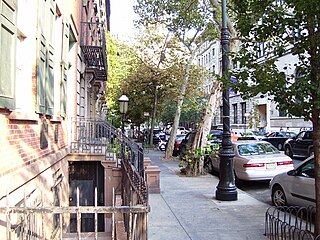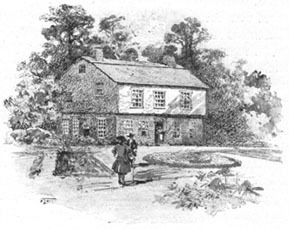Related Research Articles

Peter Stuyvesant was a Dutch colonial officer who served as the last Dutch director-general of the colony of New Netherland from 1647 until it was ceded provisionally to the English in 1664, after which it was split into New York and New Jersey with lesser territory becoming parts of other colonies, and later, states. He was a major figure in the early history of New York City and his name has been given to various landmarks and points of interest throughout the city.

The Original Dixieland Jass Band (ODJB) was a Dixieland jazz band that made the first jazz recordings in early 1917. Their "Livery Stable Blues" became the first jazz record ever issued. The group composed and recorded many jazz standards, the most famous being "Tiger Rag". In late 1917, the spelling of the band's name was changed to Original Dixieland Jazz Band.

The East Village is a neighborhood on the East Side of Lower Manhattan in New York City. It is roughly defined as the area east of the Bowery and Third Avenue, between 14th Street on the north and Houston Street on the south. The East Village contains three subsections: Alphabet City, in reference to the single-letter-named avenues that are located to the east of First Avenue; Little Ukraine, near Second Avenue and 6th and 7th Streets; and the Bowery, located around the street of the same name.

The Lower East Side, sometimes abbreviated as LES, is a historic neighborhood in the southeastern part of Manhattan in New York City. It is located roughly between the Bowery and the East River from Canal to Houston streets.

Stuyvesant Town–Peter Cooper Village, sometimes shortened to StuyTown, is a large post–World War II private residential development on the east side of the New York City borough of Manhattan. The complex consists of 110 red brick apartment buildings on an 80-acre (32 ha) tract stretching from First Avenue to Avenue C, between 14th and 23rd Streets. Stuyvesant Town–Peter Cooper Village is split up into two parts: Stuyvesant Town, south of 20th Street, and Peter Cooper Village, north of 20th Street. Together, the two developments contain 11,250 apartments.

Vatra Dornei is a town in Suceava County, north-eastern Romania. It is situated in the historical region of Bukovina. Vatra Dornei is the fifth largest urban settlement in the county, with a population of 14,429 inhabitants, according to the 2011 census.

8th Street is a street in the New York City borough of Manhattan that runs from Sixth Avenue to Third Avenue, and also from Avenue B to Avenue D; its addresses switch from West to East as it crosses Fifth Avenue. Between Third Avenue and Avenue A, it is named St. Mark's Place, after the nearby St. Mark's Church in-the-Bowery on 10th Street at Second Avenue.

Stuyvesant Street is one of the oldest streets in the New York City borough of Manhattan. It runs diagonally from 9th Street at Third Avenue to 10th Street near Second Avenue, all within the East Village, Manhattan, neighborhood. The majority of the street is included in the St. Mark's Historic District.

Bedford–Stuyvesant, colloquially known as Bed–Stuy, is a neighborhood in the northern section of the New York City borough of Brooklyn. Bedford–Stuyvesant is bordered by Flushing Avenue to the north, Classon Avenue to the west, Broadway to the east, and Atlantic Avenue to the south. The main shopping street, Fulton Street runs east–west the length of the neighborhood and intersects high-traffic north–south streets including Bedford Avenue, Nostrand Avenue, and Stuyvesant Avenue. Bedford–Stuyvesant contains four smaller neighborhoods: Bedford, Stuyvesant Heights, Ocean Hill, and Weeksville. Part of Clinton Hill was once considered part of Bedford–Stuyvesant.

"Big" Jack Zelig was an American gangster and one of the last leaders of the Eastman Gang.

"Tiger Rag" is a jazz standard that was recorded and copyrighted by the Original Dixieland Jass Band in 1917. It is one of the most recorded jazz compositions. In 2003, the 1918 recording of "Tiger Rag" was entered into the U.S. Library of Congress National Recording Registry.

St. Mark's Church in-the-Bowery is a parish of the Episcopal Church located at 131 East 10th Street, at the intersection of Stuyvesant Street and Second Avenue in the East Village neighborhood of Manhattan in New York City. The property has been the site of continuous Christian worship for more than three and a half centuries, making it New York City's oldest site of continuous religious practice. The structure is the second-oldest church building in Manhattan.

Jewish-American organized crime initially emerged within the American Jewish community during the late 19th and early 20th centuries. It has been referred to variously in media and popular culture as the Jewish Mob, Jewish Mafia, Kosher Mob, Kosher Mafia, and Kosher Nostra or Undzer Shtik. The last two of these terms are direct references to the Italian cosa nostra; the former is a play on the word for kosher, referring to Jewish dietary laws, while the latter is a calque of the Italian phrase 'cosa nostra' into Yiddish, which was at the time the predominant language of the Jewish diaspora in the United States.

Stuyvesant Square is the name of both a park and its surrounding neighborhood in the New York City borough of Manhattan. The park is located between 15th Street, 17th Street, Rutherford Place, and Nathan D. Perlman Place. Second Avenue divides the park into two halves, east and west, and each half is surrounded by the original cast-iron fence.

Bergen Square, at the intersection of Bergen Avenue and Academy Street in Jersey City, is in the southwestern part of the much larger Journal Square district. A commercial residential area, it contains an eclectic array of architectural styles including 19th-century row houses, Art Deco retail and office buildings, and is the site of the longest continually-used school site in the United States. Nearby are the Van Wagenen House and Old Bergen Church, two structures from the colonial period. St. George & St. Shenouda Coptic Orthodox Church founded by early Egyptian immigrants was one of the original Coptic congregations in New Jersey.

Chicago, Illinois is a major center for music in the midwestern United States where distinctive forms of blues, and house music, a genre of electronic dance music, were developed.

Village East by Angelika is a movie theater at 189 Second Avenue, on the corner with 12th Street, in the East Village of Manhattan in New York City. Part of the former Yiddish Theatre District, the theater was designed in the Moorish Revival style by Harrison Wiseman and built from 1925 to 1926 by Louis Jaffe. In addition to Yiddish theatre, the theater has hosted off-Broadway shows, burlesque, and movies. Since 1991, it has been operated by Angelika Film Center as a seven-screen multiplex. Both the exterior and interior of the theater are New York City designated landmarks, and the theater is on the National Register of Historic Places.

Stuyvesant Farm, also known as the Great Bowery, was the estate of Peter Stuyvesant, the last Dutch director-general of the colony of New Netherland, as well as his predecessors and later his familial descendants. The land was at first designated Bowery No. 1, the largest and northernmost of six initial estates of the Dutch West India Company north of New Amsterdam, used as the official residence and economic support for Willem Verhulst and all subsequent directors of the colony.
The Ukrainian National Home, is located at 140-142 Second Avenue in Manhattan's East Village. The building, which currently operates as a restaurant known as the Ukrainian East Village Restaurant, dates back as far as 1830, and has served as a private home, YMCA location, and the Stuyvesant Casino. UK rock band New Order played one of their first shows there on November 18, 1981.
Theatre 80 is an Off-Broadway theater located at 80 St. Mark's Place in Manhattan's East Village neighborhood. It is owned and operated by Lorcan Otway, who restored and renovated the building with his father and opened it as a theater in the 1960s. The theater was home to a number of productions, including the 1967 premiere of You're a Good Man, Charlie Brown whose revenue helped the Otways keep the theater. By 1971, it became a movie theater.
References
- ↑ Mason, Pete (29 May 2021). "Stuyvesant Casino: The East Village home for Jewish Gangsters and Dixieland Jazz - NYS Music". NYSMusic.com. Retrieved 14 June 2021.
- ↑ Berman, Andrew (16 November 2017). "Jewish gangsters, jazz legends, and Joy Division: The evolution of the Ukrainian National Home". 6sqft. Retrieved 14 June 2021.
- ↑ Calhoun, Ada (2015-11-02). St. Marks Is Dead: The Many Lives of America's Hippest Street. W. W. Norton & Company. p. 79. ISBN 978-0-393-24979-8 . Retrieved 15 June 2021.